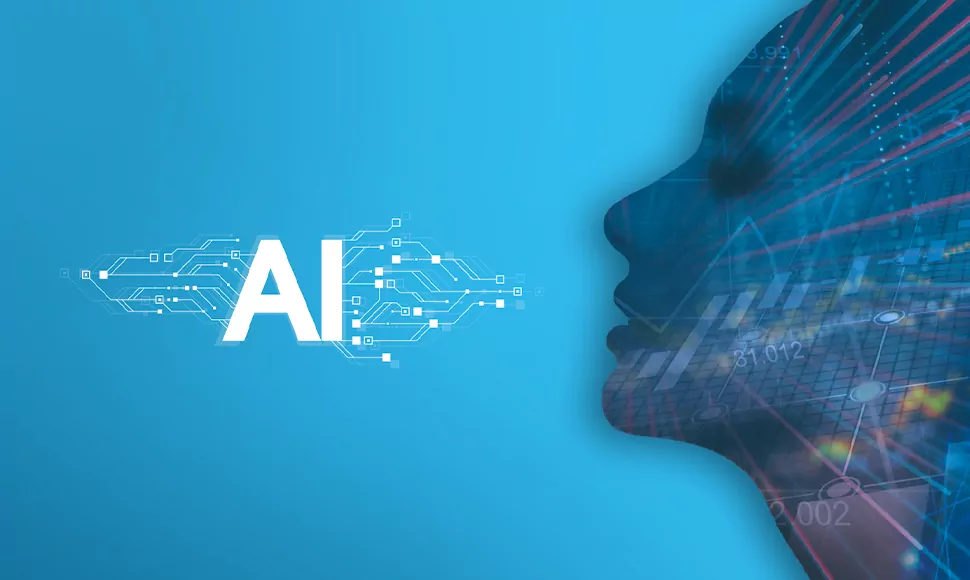2023 will be remembered as a year of extraordinary transformations in software production. The establishment of Artificial Intelligence and Machine Learning has made applications more and more advanced. Conversely, the evolution of quantum computing generates excellent expectations for new technological discoveries in the high-tech realm, accompanied by progressively sophisticated methods in cybersecurity.
Check how the face of technology is changing and what software development trends await us in 2024.
Rise of AI and Machine Learning as Latest Software Development Trends
As we move into 2024, Artificial Intelligence (AI) and Machine Learning (ML) are not just emerging trends but have become fundamental in software development. OpenAI, associated by many with the GPT chat, is an entry into the use of artificial intelligence through the OpenAI API. Chatbots created thanks to OpenAI are already commonplace, but more advanced functions are appearing thanks to intensive development, such as RoboSumo or OpenAI Codex. Their influence is pervasive, changing how software is conceived, developed, and deployed across industries.
Evaluation of AI and ML Tools
Tools such as GitHub Copilot and OpenAI, which have been at the forefront of this revolution, continue to evolve. These frameworks have become more sophisticated, offering enhanced capabilities that enable developers to build functionally advanced applications and imbued with a level of previously unattainable intelligence. New features and optimizations in these tools are making AI and ML development more accessible, efficient, and scalable.
MLOPS (Machine Learning Operations) tools have rapidly grown and developed. The tools started appearing around 2018, but recently, they have become more and more mature and ready to use.
Expansion of AI-Driven Capabilities
In 2024, we are witnessing an expansion in the capabilities of AI-driven applications. This ranges from advanced natural language processing, which allows for more nuanced and context-aware interactions, to breakthroughs in computer vision, enabling software to interpret and analyze images and videos with unprecedented accuracy.
Integration in Diverse Domains
The integration of AI and ML is not confined to traditional tech sectors. We see a broadening of horizons where these technologies are applied in fields such as healthcare, predictive diagnostics, finance for risk assessment and fraud detection, and retail for personalized customer experiences. This cross-industry adoption signifies recognizing the transformative power of AI and ML.
Enhanced User Experiences
One of the most notable impacts of AI and ML in 2024 is on user experience. Software applications are becoming more intuitive and user-friendly, with AI algorithms working behind the scenes to personalize and enhance user interaction. This leads to more effective software products aligned with user preferences and behaviors.
A significant trend in 2024 is the heightened focus on ethical AI and reducing biases in machine learning models. There’s an increasing awareness and effort in the development community to ensure that AI systems are fair, transparent, and accountable, addressing potential ethical issues that arise from automated decision-making processes.
Collaboration and Open Source Contributions
Finally, the AI and ML landscape 2024 is marked by increased collaboration and open-source contributions. The community around these technologies continues to grow, with developers sharing knowledge, resources, and code. This collaborative environment fosters innovation and accelerates the advancement of AI and ML technologies, benefiting the entire software development ecosystem.
2024 stands as a year where AI and ML consolidate their position in software development and push the boundaries of what is possible, driving innovation and creating more innovative, responsive, and ethical software solutions.
Quantum Computing Integration in 2024: Revolutionizing Industries
This year marks a pivotal moment in quantum computing, transitioning from a largely theoretical and experimental domain to a more accessible and practical tool in mainstream software development. This software development trend is particularly evident in industries such as pharmaceuticals, aerospace, and finance, where the unique capabilities of quantum computing are being harnessed to solve problems previously beyond reach.
Pharmaceutical Industry Transformation
In the pharmaceutical industry, quantum computing is revolutionizing drug discovery and development. By simulating molecular and chemical interactions at a quantum level, researchers can identify new drug candidates and predict their effects more quickly and accurately. This speeds up the development process and enhances the precision of treatments, paving the way for personalized medicine.
Advancements in Aerospace Engineering
In aerospace, quantum computing is integrated into various design and simulation aspects. The ability of quantum computers to process vast amounts of data at unprecedented speeds allows for more sophisticated modeling of aerodynamic processes, material stress analysis, and optimization of flight trajectories. This leads to safer, more efficient aircraft designs, potentially revolutionizing space exploration.
Revolutionizing Finance with Quantum Algorithms
The finance industry leverages quantum computing for complex risk analysis, portfolio optimization, and algorithmic trading. Quantum algorithms offer the ability to analyze market data and predict trends with depth and speed unattainable by classical computing methods. This capability transforms financial strategies, leading to more robust and effective economic models and investment strategies.
Educational and Skills Development Focus
As quantum computing becomes more integrated into software development, there’s a growing focus on education and skills development in this field. Universities and online platforms are introducing courses on quantum computing, and companies are investing in training programs to prepare software developers for this new technological landscape.
Collaborative Ecosystem and Open Source Initiatives
A collaborative ecosystem comprising academia, industry, and government entities facilitates the integration of quantum computing into software development. Open source initiatives play a crucial role, providing accessible platforms for experimentation and innovation in quantum computing.
Challenges and Ethical Considerations
Despite these advancements, integrating quantum computing into mainstream software development presents challenges, including hardware limitations, algorithm complexity, and ethical considerations regarding its use and impact. Addressing these challenges is essential for quantum computing technologies’ sustainable and responsible advancement.
In conclusion, 2024 is witnessing a significant integration of quantum computing into software development, with transformative impacts across various industries. This integration enhances computational capabilities and redefines what’s possible in pharmaceuticals, aerospace, and finance, heralding a new technological innovation and application era.
Cybersecurity Focus in 2024: The Evolution of Security in Software Development Industry
While on cybersecurity, 2024 marks a significant shift in the approach to cybersecurity within software development. As digital threats have become more sophisticated and pervasive, the focus on cybersecurity has evolved correspondingly.
Integration of Security in Development Lifecycle
A key trend in 2024 is the integration of security practices right from the early stages of the software development lifecycle. This approach, often called DevSecOps, incorporates security considerations and checks into every development phase, from initial design to deployment and maintenance. By doing so, security becomes a continuous and integral part of the process rather than a separate or final phase.
Rise of DevSecOps
DevSecOps has become a framework that seamlessly blends development, security, and operations. This paradigm shift ensures that security considerations are included and a driving factor in the development process. It encourages collaboration between development, security, and operations teams, fostering a culture where security is a shared responsibility.
Proactive Threat Detection and Mitigation
The focus on cybersecurity in 2024 also includes a more proactive stance on threat detection and mitigation. Advanced tools and techniques, such as AI-driven security analytics, real-time threat monitoring, and automated vulnerability scanning, are employed to identify and address potential security issues before they can be exploited.
AIOps: Revolutionizing Cybersecurity Strategies
2024 has also witnessed the rise of Artificial Intelligence for IT Operations (AIOps) in enhancing cybersecurity measures. AIOps leverages machine learning and big data analytics to automate and improve IT operations, including cybersecurity.
AIOps can detect and respond to security threats more rapidly and accurately than traditional methods by analyzing vast amounts of data from various sources in real-time. This technology helps identify patterns and anomalies that could indicate a cybersecurity threat, allowing for preemptive action.
Security in Cloud and Remote Environments
With the continued rise of cloud computing and remote work environments, there is a heightened focus on securing cloud-based applications and infrastructure. This includes enhancing security protocols for remote access, implementing robust data encryption methods, and ensuring compliance with various data protection regulations.
Regulatory Compliance and Data Privacy
As data privacy and security regulations become more stringent, compliance has become a significant concern in software development. Developers are increasingly required to ensure that their products comply with various international and regional data protection laws, such as GDPR and CCPA, which has led to integrating compliance checks into the development workflow. In addition, there are regulations regarding data collection through AI or copyrights on generated queries – all these topics will undoubtedly be among the trends this year.
Quantum Computing’s Role in Cybersecurity
The advent of quantum computing in 2024 has started redefining cybersecurity. Quantum computing, with its ability to perform complex calculations at unprecedented speeds, presents both a challenge and an opportunity for cybersecurity.
On one hand, it poses a significant threat to traditional encryption methods, potentially making current cybersecurity measures obsolete. On the other hand, quantum computing offers innovative ways to develop new, virtually unbreakable encryption techniques, such as quantum key distribution.
This dual aspect of quantum computing is leading to a paradigm shift in cybersecurity strategies, with a greater emphasis on developing quantum-resistant encryption algorithms to safeguard data against future quantum-based attacks.
As a result, cybersecurity experts and software developers are increasingly focusing on quantum-proofing their security protocols to ensure long-term data protection in a quantum computing era.
Challenges and Ethical Implications
Despite these advancements, the cybersecurity landscape in 2024 has changed. Balancing security needs with user experience, dealing with the complexities of emerging technologies, and addressing the ethical implications of surveillance and data collection are ongoing concerns the industry continues to grapple with.
In conclusion, 2024 has seen a pivotal shift in how cybersecurity is perceived and implemented in software development. The focus has shifted from reactive measures to a more holistic, integrated, and proactive approach, embedding security at every development lifecycle stage. This shift is crucial in building more secure, resilient, and trustworthy software systems in an increasingly digital world.

Low-Code Development in 2024: Empowering a Broader Range of Creators
The year 2024 will witness a significant surge in the popularity and adoption of low-code and no-code platforms, marking a pivotal moment in the democratization of software development. These platforms have become more than just a trend; they are now fundamental tools that enable a vast range of individuals, regardless of their technical background, to participate in the creation of software applications.
Bridging the Technical Divide
One of the most profound impacts of low-code and no-code platforms is their ability to bridge the gap between technical and non-technical users. They allow business analysts, project managers, and other professionals to develop functional applications without writing complex code. This empowerment leads to a more inclusive environment where ideas and solutions can be rapidly prototyped and implemented without the traditional barriers of software development.
Enhanced Features and Capabilities
In 2024, low-code and no-code platforms are evolving significantly, offering enhanced features and superior capabilities. They now support a more comprehensive range of applications, from simple web apps to complex business processes and IoT integrations. These platforms have become more intuitive, with drag-and-drop interfaces, pre-built templates, and advanced integration options, making the development process more efficient and user-friendly.
Impact on Professional Development
The rise of low-code and no-code platforms also influences the landscape of professional development and education. Traditional developers find value in these platforms for rapid prototyping and testing ideas, while individuals without formal programming education are gaining new avenues for career advancement in the tech industry.
Challenges and Considerations
Another software development trend, the proliferation of low-code and no-code platforms, also brings challenges. Concerns around the scalability, security, and customization of applications created with these tools are prevalent. Additionally, there’s an ongoing need to balance the simplicity of low-code/no-code development with the complex requirements of specific software projects.
Future Outlook
Looking forward, the trajectory of low-code and no-code platforms suggests a continuing evolution in their capabilities and reach. As these platforms become more advanced and widespread, they are likely to play an increasingly significant role in shaping the future of software development, making it more accessible, inclusive, and aligned with the fast-changing needs of businesses and individuals.
In summary, 2024 stands as a landmark year for low-code and no-code platforms, significantly altering the landscape of software development by enabling a broader range of people to create and contribute to software solutions, thus democratizing the field of software development.
Sustainable Software Engineering in 2024: A Green Revolution in Tech
The year 2024 will bring a significant rise in awareness regarding the environmental impact of software development. This heightened consciousness drives a shift towards sustainable software engineering practices, focusing on reducing digital products’ carbon footprint and ecological burden.
Emphasis on Energy-Efficient Coding
A key aspect of sustainable software engineering is the emphasis on energy-efficient coding. Developers are increasingly adopting practices that optimize code for energy efficiency, reducing the power consumption of applications. This involves writing leaner code, optimizing algorithms for performance, and choosing more energy-efficient hardware and software platforms.
The previously mentioned quantum computers consume much less energy, which may be crucial for the trends and future of software development because training and running AI models is currently very power-hungry.

Eco-Friendly Cloud Computing
Cloud computing, a staple in modern software infrastructure, is also transforming. In 2024, there’s a significant push towards eco-friendly cloud services. Data centers are adopting renewable energy sources and improving their cooling and power management systems to minimize their environmental footprint. Cloud service providers offer more transparent carbon footprint metrics, enabling companies to make informed choices about cloud usage.
Lifecycle Assessment and Eco-Design
Software development in 2024 is seeing a growing implementation of lifecycle assessment (LCA) methodologies. LCA involves evaluating the environmental impact of software throughout its lifecycle, from development and deployment to maintenance and decommissioning. This holistic view helps identify and mitigate the environmental effects at every stage. Eco-design principles are being integrated into the software development process, focusing on sustainability from the design phase.
Sustainable DevOps Practices
DevOps practices, crucial for modern software development, are evolving to incorporate sustainability. This involves optimizing continuous integration and deployment pipelines for energy efficiency, reducing resource wastage, and using monitoring tools to track and improve the environmental impact of software operations.
Green Computing Education and Advocacy
2024 also sees an increase in green computing education and advocacy. Universities and online learning platforms are introducing courses on sustainable software engineering, while industry conferences and seminars are increasingly focusing on environmental impact. This educational push creates a new generation of environmentally conscious developers skilled in sustainable practices.
Open Source Contributions to Sustainability
The open-source community is playing a pivotal role in sustainable software engineering. Collaborative projects focused on sustainability are gaining traction, providing tools, libraries, and frameworks that help developers build more environmentally friendly software.
Challenges and Future Outlook
While strides are being made in sustainable software engineering, challenges remain. Balancing performance, cost, and environmental impact is a complex task, and the tech industry is still in the early stages of understanding and addressing its total environmental impact. However, the momentum in 2024 is a promising sign of a more sustainable and environmentally responsible software industry in the future.
In conclusion, sustainable software engineering in 2024 reflects a growing recognition of the tech industry’s environmental responsibility. With an increased emphasis on energy efficiency, lifecycle assessment, and eco-friendly practices, the software development community is making significant strides in reducing the environmental impact of digital products, paving the way for a greener, more sustainable future in technology.
Wrap-up
To sum up, 2024 will remain a year of dynamic transformation in software development. The integration of advanced technologies such as artificial intelligence, machine learning, and quantum computing, combined with a focus on cybersecurity, sustainability, and regulatory compliance, will shape the future of how software is developed and used across sectors.
This evolution is heading towards an end where technology is more advanced, safe, sustainable, and accessible.
If you are wondering how to use trends in building software for your company – schedule a free consultation with our expert.





